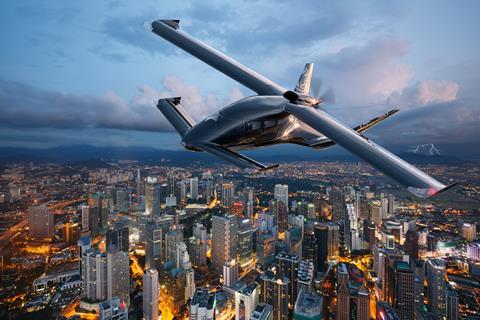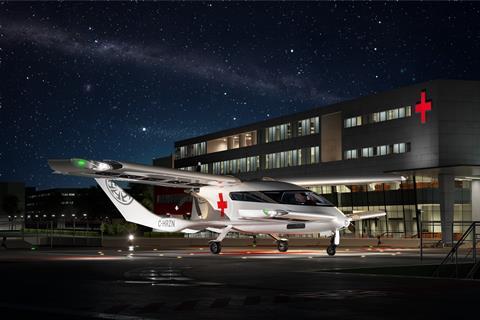Retired fighter pilot Brandon Robinson believes his company’s recent manoeuvres have positioned it for long-term success.
The Canadian air taxi developer – Horizon Aircraft – has completed its combination with Hawaii-based Pono Capital Three and is now listed on the US stock exchange as a publicly traded company. As of 16 January, the combined company is operating as New Horizon Aircraft and trading under the ticker “HOVR”. It is a significant milestone for the Ontario-based firm.
“Fundamentally, it was an opportunity to share our message with some retail investors that can get on board with a reasonable company at a very reasonable valuation and come along for the ride,” he told FlightGlobal earlier this month. “We have the right partners on board with opportunities for future financing, as well.”
The move comes on the heels of Horizon forming a five-member board of directors to guide the company through development, certification and commercialisation of its hybrid-electric vertical take-off and landing (eVTOL) vehicle, known as the Cavorite X7.

“We had two choices: pick a celebrity board that’s got a lot of fancy names on it – but those people are busy and hard to assemble – or assemble a very functional board that has a lot of deep experience in exactly the things we want to do,” he says. ”We picked door number two; it’s a very practical company.”
Positioned in the second wave of eVTOL makers, Horizon’s leadership saw an opportunity in the slow-down of initial public offerings (IPOs) in recent months, believing that the trend will reverse – and that Horizon will benefit from following in the footsteps of air taxi companies that went public by merging with special purpose acquisition companies (SPACs). Air taxi developers that became public firms during the SPAC boom include Archer Aviation, Eve Holding, Joby Aviation, Lilium and Vertical Aerospace.
“A lot of those early companies that [went public] during the height of the SPAC craziness spent a significant amount of their money on lobbying, trying to get the FAA and EASA to write down some rules,” Robinson says. “We are fortunate that those companies trail-blazed the way in terms of forcing regulatory bodies to at least provide frameworks for certification.”
Access to additional capital is critical as the cost of developing a clean-sheet aircraft and pushing it through certification are “huge”, he says.
In that regard, Horizon has an advantage, according to Robinson: It is seeking certification first with Transport Canada. Not only is it “a little nicer to pay Canadian dollars than American dollars right now”, he says, but Transport Canada is not inundated with dozens of applications from start-ups seeking certification of novel aircraft designs.
“In Canada, there is really only us in terms of serious advanced air mobility players that have any kind of prototype or developmental trajectory to get certification,” he says. “That affords us some special relationships and a bit more flexibility to move things forward.”
Horizon has a bilateral agreement with the FAA intended to streamline approval in the USA after it secures type certification of the X7 with Transport Canada, Robinson says.
The start-up is still testing its half-scale prototype, with an eye on transitioning from hovering to forward flight within the next couple of months. It will then turn attention to assembling its first full-scale prototype in Lindsay, Ontario, which it hopes to flight test as soon as 2026. Type certification is targeted for the following year, assuming no delays in development.

Though its conceptual aircraft fits with the futuristic-looking designs being proposed by dozens of advanced air mobility companies around the world, Horizon is taking a modest approach to development, Robinson says. The intention is to “under-promise and over-deliver from a technical perspective”.
The aircraft will have wing-mounted lifting props and an aft pusher-prop. The electric system will provide lift during take-off and landing, while the propulsion system will rely exclusively on jet fuel for power during conventional flight.
Performance is the main consideration that caused Horizon to buck the trend of all-electric air taxis promising no-emissions flight, Robinson says. ”When you’re flying in the real world and for for-profit operations, we came down to the fact that you needed much more endurance on board – you need much more speed and operational flexibility than any electric powertrain can handle.”
Intending to optimise the aircraft for operations in austere locations with very little infrastructure – for example, villages in far-northern Canada – Horizon has designed it to be able to recharge its batteries “without finding the world’s longest extension cord”, Robinson says.
“Now, we are very enthusiastic about where batteries are going,” he adds. ”When battery technology gets past a certain threshold, five years or 10 years from now, we can go all-electric.”
Meanwhile, the start-up will focus on building the commercial case for its aircraft. On that front, Horizon recently reached a provisional agreement with Indian executive jet operator JetSetGo for the purchase of up to 100 of the Cavorite X7.


























